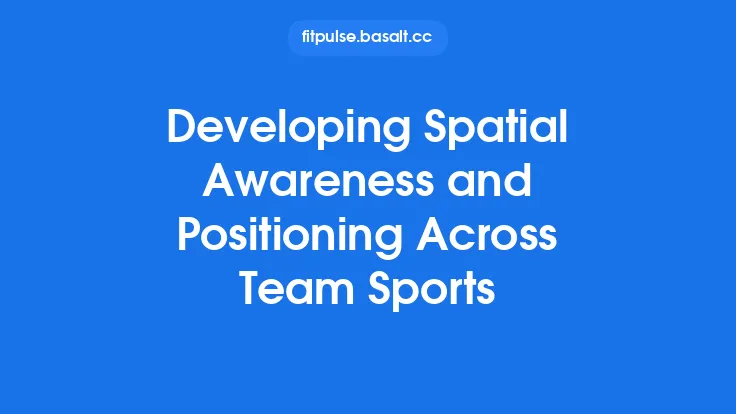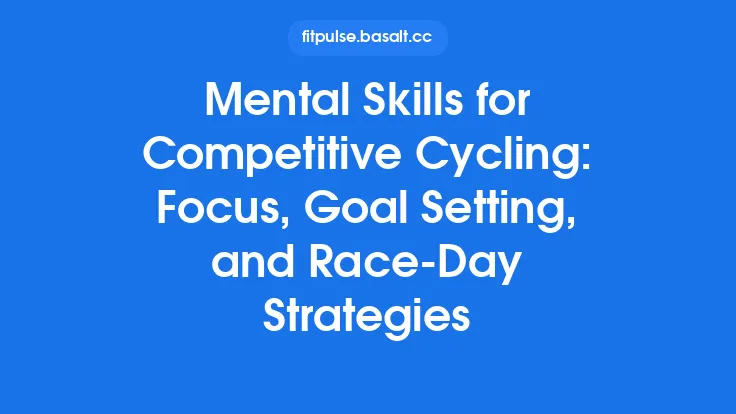In the fast‑paced world of team sport, the ability to read the unfolding action, anticipate teammates’ and opponents’ movements, and make the right choice at the right moment is what separates good athletes from great ones. This intuitive “game sense” does not appear overnight; it is cultivated through repeated exposure to realistic, decision‑rich environments. Small‑sided games (SSGs) and scenario‑based play are two of the most powerful, evergreen tools coaches can use to embed situational awareness into the fabric of an athlete’s skill set. By deliberately shaping the constraints of a drill, you can create a micro‑cosm of the full‑size match that forces players to constantly scan, interpret, and act—building the mental scaffolding that underpins tactical proficiency.
Understanding Situational Awareness in Team Sports
Situational awareness is the continuous process of perceiving relevant cues, comprehending their meaning, and projecting future states. In a sporting context, this translates to:
- Perception – noticing the position of the ball, teammates, opponents, and space.
- Comprehension – interpreting how those elements interact (e.g., a defender’s angle of approach, a teammate’s run).
- Projection – anticipating the next logical development (e.g., where a pass will be received, where a defensive line will shift).
While the three components are conceptually distinct, they are inseparable in practice. An athlete who can only see the ball but not the surrounding players will make sub‑optimal choices; one who sees the players but cannot predict the next movement will lag behind the play. The goal of training is to fuse perception, comprehension, and projection into a seamless, automatic process.
Why Small‑Sided Games Are Ideal for Developing Awareness
Small‑sided games condense the essential elements of a full match into a reduced playing area with fewer participants. This compression yields several unique benefits for situational awareness:
| Benefit | Explanation |
|---|---|
| Higher Interaction Density | With fewer players, each touch, run, or defensive shift becomes more consequential, forcing athletes to process information quickly. |
| Increased Touch Frequency | Players receive the ball more often, providing more opportunities to practice reading the game from both offensive and defensive perspectives. |
| Controlled Spatial Constraints | By adjusting pitch dimensions, you can emphasize specific tactical concepts (e.g., tight spaces for quick decision‑making, larger zones for spatial awareness). |
| Scalable Complexity | Adding or removing rules, goals, or player roles allows you to gradually raise the cognitive demands without overwhelming athletes. |
| Enhanced Engagement | The competitive, game‑like nature of SSGs sustains motivation, ensuring athletes stay mentally present throughout the drill. |
Because SSGs are inherently game‑like, the information athletes must process mirrors that of a real match, making the transfer of learned awareness to competition highly efficient.
Core Design Elements of Effective Small‑Sided Games
To harness the full potential of SSGs for situational awareness, coaches should deliberately manipulate four primary constraints:
- Numerical Ratio
- Balanced (e.g., 4v4): Replicates typical match dynamics, encouraging equal distribution of responsibilities.
- Numerical Superiority/Inferiority (e.g., 5v3): Forces the outnumbered side to prioritize defensive organization and the dominant side to manage possession under pressure.
- Spatial Dimensions
- Compact (e.g., 30 × 20 m): Emphasizes quick, short‑range decisions and tight ball control.
- Extended (e.g., 50 × 35 m): Allows for longer passes, deeper runs, and the need to read larger zones of space.
- Scoring Modifications
- Goal Zones: Assign different point values to zones (e.g., central goal = 2 points, side goals = 1 point) to direct attention to specific areas.
- Conditional Scoring: Award points only when a pass is completed before a defender reaches a defined line, encouraging anticipation of defensive pressure.
- Rule Constraints
- Touch Limits: Restrict the number of touches per player (e.g., two‑touch rule) to accelerate decision speed.
- Mandatory Pass Types: Require a certain proportion of passes to be forward, diagonal, or through‑ball, prompting players to scan for specific options.
- Positional Restrictions: Designate zones where only certain players may operate, compelling the rest to adjust positioning and support.
By systematically varying these constraints, coaches can target specific facets of situational awareness—such as scanning for open lanes, recognizing defensive shapes, or anticipating teammate runs—while keeping the drill fresh and challenging.
Scenario Play: Replicating Game‑Specific Contexts
Scenario play takes the concept of SSGs a step further by embedding a concrete match situation into the drill. Rather than a generic “play the game,” athletes are asked to solve a defined problem, such as defending a one‑minute counter‑attack or breaking down a compact defensive block in the final third.
Key Steps to Build a Scenario:
- Identify the Tactical Objective
Choose a moment that aligns with the team’s strategic priorities (e.g., transition defense, set‑piece organization, high‑press recovery).
- Define the Starting Conditions
- Possession: Who has the ball?
- Field Position: Where on the pitch does the scenario begin?
- Time Constraint: Is there a countdown that simulates a real‑time pressure?
- Set Success Criteria
Clearly articulate what constitutes a successful outcome (e.g., regain possession within 10 seconds, create a shot on goal within 15 seconds).
- Introduce Realistic Constraints
- Limited Substitutions: Mimic fatigue by restricting player rotations.
- Environmental Factors: Use cones or markers to represent obstacles like a full‑back line or a crowded midfield.
- Debrief Immediately
After each run, pause for a brief discussion focused on what information players used, what they missed, and how they could improve their reading of the situation.
Example Scenario – “The Last‑Minute Break” (Soccer)
- Objective: Convert a counter‑attack into a goal within 30 seconds.
- Setup: 5 attackers vs. 4 defenders, half‑field. Attackers start with the ball at the midfield line; defenders must retreat to a defensive line 20 m from their goal.
- Constraints: Attackers may only use one through‑ball before shooting; defenders can only step forward after the ball crosses the midfield line.
- Success: Goal scored or a shot on target within the time limit.
Such scenarios force players to constantly monitor opponent positioning, anticipate movement, and make rapid, context‑specific decisions—exactly the type of situational awareness that translates to match performance.
Progression Strategies: From Simple to Complex
Developing situational awareness is a gradual process. Coaches should scaffold learning by moving athletes through a series of increasingly demanding tasks.
| Stage | Focus | Example Drill |
|---|---|---|
| 1. Perception Warm‑Up | Isolate visual scanning | “Look‑Around” drill: players stand in a circle, a coach calls out a number; the player must point to the teammate holding that number while maintaining awareness of surrounding movement. |
| 2. Basic SSG | High touch frequency, minimal constraints | 4v4 on a 30 × 20 m grid, no touch limits, normal scoring. |
| 3. Constraint‑Added SSG | Introduce one rule (e.g., two‑touch) | 4v4 with two‑touch rule, encouraging quick scanning for passing lanes. |
| 4. Numerical Imbalance | Force decision under pressure | 5v3 on a compact grid, outnumbered side must defend a small goal. |
| 5. Scenario Integration | Apply a specific tactical problem | “Defend the Counter” – 6 attackers vs. 5 defenders, attackers start with the ball in their own half, defenders must win the ball within 12 seconds. |
| 6. Full‑Context Replication | Near‑match conditions | 8v8 on a half‑field with regular stoppages, time limits, and coaching cues mirroring a real match. |
Each stage should be mastered before progressing, ensuring that athletes have built a solid foundation of perception before being asked to process more complex information.
Sport‑Specific Templates
While the underlying principles are universal, the exact configuration of SSGs and scenarios varies by sport. Below are concise templates for three popular team sports.
1. Basketball – “Pick‑and‑Roll Pressure”
- Players: 3v3
- Court Size: Half‑court, 14 × 15 m
- Constraints: The ball‑handler may only dribble once before passing; defenders must rotate to guard the screener after the pick.
- Goal: Score within 15 seconds of gaining possession.
- Awareness Target: Recognize when the defender is over‑committing, locate the open cutter.
2. Field Hockey – “Fast‑Break Transition”
- Players: 4v4
- Field Size: 30 × 20 m (half‑field)
- Constraints: After a turnover, the defending team has 8 seconds to regain possession; the attacking team must attempt a shot on goal within 12 seconds.
- Goal: Successful shot or turnover.
- Awareness Target: Scan for open lanes, anticipate opponent’s defensive shape.
3. Rugby Union – “Ruck‑to‑Backline Flow”
- Players: 5v5
- Pitch Size: 40 × 30 m
- Constraints: After a ruck is formed, the ball must be passed to the backline within 5 seconds; defenders can only enter the ruck after the ball is on the ground.
- Goal: Complete a backline move that results in a try or a line‑break.
- Awareness Target: Identify the quickest support runner, read defensive line shift.
These templates can be adapted by adjusting player numbers, field dimensions, or rule constraints to suit the specific developmental stage of the athletes.
Coaching Feedback and Observation Techniques
Effective feedback is the bridge between the drill and the athlete’s internalization of situational cues. Rather than focusing on isolated technical execution, coaches should comment on the information processing displayed.
- Descriptive Over Prescriptive
- Descriptive: “You turned your head just before the defender cut in, which gave you a clear passing lane.”
- Prescriptive: “Pass the ball to the left.”
Descriptive feedback reinforces the scanning behavior that led to the correct decision.
- Cue‑Based Questioning
Ask open‑ended questions that prompt self‑analysis:
- “What did you notice about the defender’s positioning before you made that pass?”
- “Which teammate’s run gave you the best option at that moment?”
- Micro‑Video (Optional, Non‑Analytical)
If a short clip is available, replay a 3‑second segment focusing solely on the player’s head movement or eye line, without adding technical commentary. This visual cue helps athletes become aware of their own scanning habits.
- Positive Reinforcement of Scanning
Highlight moments when a player correctly anticipates an opponent’s move, even if the execution was imperfect. This encourages continued effort in information gathering.
- Use of “Think‑Aloud”
During a pause, ask a player to verbalize what they are seeing and considering. This externalizes the internal decision‑making process, making it easier to coach.
Integrating Small‑Sided Games into a Weekly Plan
To keep situational awareness development consistent, embed SSGs and scenario play throughout the training week, balancing them with technical, physical, and recovery sessions.
| Day | Session Focus | Sample SSG/Scenario |
|---|---|---|
| Monday | Technical refinement (passing, shooting) | 4v4 “Two‑Touch” drill on a compact grid |
| Tuesday | Physical conditioning + tactical | 5v3 “Numerical Superiority” with a time‑limited scoring rule |
| Wednesday | Recovery / low‑intensity | “Look‑Around” perception warm‑up, no contact |
| Thursday | Scenario‑based tactical | “Defend the Counter” (sport‑specific) with coach‑set constraints |
| Friday | Full‑team scrimmage | 8v8 half‑field game, incorporating the week’s learned constraints |
| Saturday | Match day or simulated match | Apply situational awareness naturally |
| Sunday | Rest / active recovery | Light mobility work, optional video of previous day’s scenarios for discussion (no deep analysis) |
By rotating the emphasis—technical, physical, scenario—players experience a continuous stream of decision‑rich environments without overloading any single training component.
Common Pitfalls and How to Avoid Them
| Pitfall | Why It Undermines Awareness | Remedy |
|---|---|---|
| Over‑Complicating Early Drills | Too many constraints overwhelm perception, leading players to focus on rule compliance rather than scanning. | Start with simple SSGs; add one constraint at a time once players demonstrate comfortable scanning. |
| Static Repetition | Repeating the same drill reduces novelty, causing players to rely on memorized patterns instead of reading the situation. | Vary pitch size, player ratios, and scoring rules regularly. |
| Excessive Coaching Interruption | Constant verbal input stalls the natural flow of information processing. | Use brief, targeted feedback after a set of repetitions, not after every single play. |
| Neglecting Defensive Scanning | Focusing only on offensive decision‑making creates a one‑sided awareness. | Include defensive‑focused SSGs where the primary goal is to read opponent movement and intercept. |
| Ignoring Fatigue Effects | Situational awareness deteriorates under fatigue, but drills often run at full freshness. | Schedule some SSGs later in the session or after conditioning work to simulate match‑day fatigue. |
Addressing these issues ensures that the training environment remains conducive to the development of genuine, transferable awareness.
Measuring Development Without Relying on Complex Metrics
While sophisticated data collection can be valuable, the core of situational awareness is observable behavior. Simple, qualitative markers can effectively track progress:
- Head‑Up Frequency
Count the number of times a player lifts their head before receiving or releasing the ball during a drill. An upward trend indicates improved scanning.
- Decision Latency
Use a stopwatch to time the interval between a player’s first visual cue (e.g., a defender’s approach) and their subsequent action (pass, dribble, tackle). Shortening this interval reflects faster information processing.
- Correct Option Selection Ratio
After each play, note whether the player chose the most advantageous option based on the current configuration (e.g., passing to the player in space versus a forced pass). Track the percentage over multiple sessions.
- Recovery Success Rate
In defensive scenarios, record how often a player successfully regains possession after a turnover within a set time frame. Improvement signals better reading of opponent intent.
These observations can be logged in a simple spreadsheet, providing a clear narrative of each athlete’s growth without the need for high‑tech tracking systems.
Conclusion: Making Situational Awareness a Habit
Situational awareness is not a static skill; it is a habit formed through repeated exposure to realistic, decision‑laden environments. Small‑sided games and scenario play offer the perfect laboratory for this habit‑building, delivering high interaction density, purposeful constraints, and immediate relevance to match play. By thoughtfully designing drills, progressing complexity, providing focused feedback, and embedding these activities within a balanced weekly schedule, coaches can nurture athletes who instinctively scan, interpret, and act—turning tactical knowledge into on‑field instinct.
The result is a team that moves as a cohesive, aware unit, capable of adapting to the ever‑changing dynamics of sport. When every player consistently reads the game as it unfolds, the collective tactical intelligence of the squad rises, and performance gains become a natural by‑product of everyday training.





